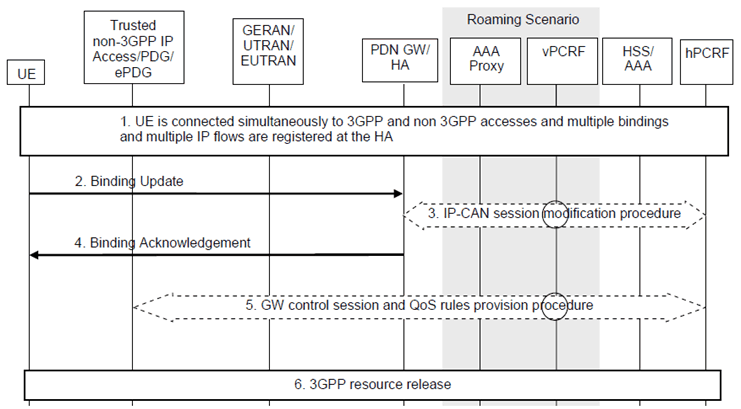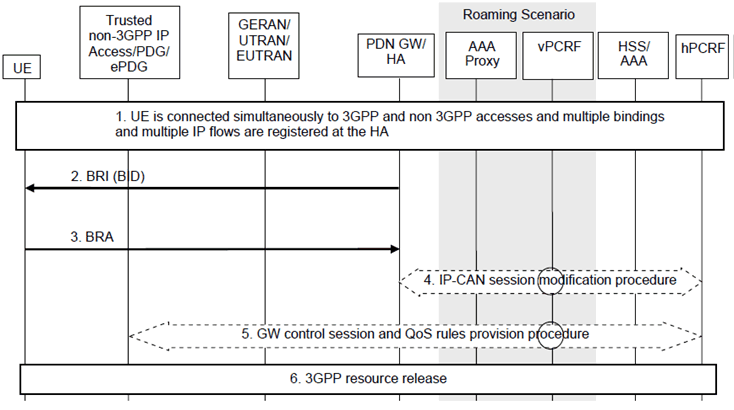Content for TS 23.261 Word version: 18.0.0
5.5 Removal of an access from a PDN connection
5.5.1 UE-initiated removal of an access from a PDN connection
5.5.2 HA-initiated removal of an access from a PDN connection
5.6 Addition of one access for multiple PDN connections to the same APN
5.7 Detach and PDN disconnection procedures
$ Change history
5.5 Removal of an access from a PDN connection p. 18
5.5.1 UE-initiated removal of an access from a PDN connection p. 18
In this scenario, the UE is attached to a 3GPP access and a WLAN access and is using both the accesses for the same PDN connection. Subsequently, the UE moves all IP flows associated with one access to another access and disconnects from the one access (e.g. due to loss of coverage or by an explicit detach).
The optional interaction steps between the gateways and the PCRF in the procedures only occur if dynamic policy provisioning is deployed in EPC. These steps are never present when the solution is applied to I-WLAN mobility architecture according to TS 23.327.

Step 1.
If the BID associated with the WLAN access is removed, according to TS 23.402 the security associations between the UE and the HA should not be immediately deleted. As the security associations were created dynamically using IKEv2 they will be automatically deleted when they expire. Similarly, for I-WLAN mobility architecture, the H2 session between the HA and the AAA Server should not be immediately deleted. The H2 session will be deleted by the HA immediately after security associations are deleted. In case of I-WLAN mobility architecture, the UE may initiate release of the IKEv2 security association with the PDG according to TS 23.234.
The UE is simultaneously connected to a 3GPP access and a WLAN access based on the procedures specified in clauses 5.2 and 5.3. Based on current routing rules some IP flows are routed through the 3GPP access and some other IP flows through the WLAN access.
Step 2.
The UE decides to move all IP flows to one access and to disconnect from the other access (e.g. due to loss of coverage, based on internal trigger, based on updated policies from ANDSF).
Step 3.
- If UE disconnects one access (either a home link or a foreign link) and maintains the other access which is the foreign link, the UE sends a Binding Update (Lifetime, HoA, BID) to the HA with lifetime set to 0 to remove the BID of the access it disconnects from. Or, alternatively, the UE sends a Binding Update (HoA, BID) over the maintained foreign link to the HA with lifetime set to non-zero, the BID of the maintained foreign link, and "O" flag set.
- If the UE disconnects the WLAN access which is a foreign link and maintains only the 3GPP access which is the home link, the UE sends a Binding Update with lifetime 0 without any BID. This de-registration Binding Update can be sent from any available access.
In case the HA function is located in the PDN GW, the PDN GW initiates the IP-CAN session modification procedure with the PCRF. In this procedure, the PDN GW removes the routing address related to the removed BID associated with the IP-CAN session.
Step 4.
The HA sends a Binding Acknowledgment (Lifetime, HoA, BID) as specified in RFC 5555, RFC 5648 and RFC 6089.
Step 5.
If the HA function is located in the PDN GW, as part of the IP-CAN session modification procedure initiated in step 3, the PCRF ensures that the relevant QoS rules for the SDFs are installed in the target BBERF. This is done by a GW control session and QoS rules provision procedure as specified in TS 23.203.
Step 6.
If in step 2 the UE has removed the BID associated with the 3GPP access and maintained the BID for the WLAN access, the PDN GW shall initiate the PDN GW Initiated PDN Disconnection procedure in 3GPP access as defined in clause 5.6.2.2 of TS 23.402 or the PDN GW Initiated Bearer Deactivation procedure as defined in clause 5.4.4.1 of TS 23.401. The PDN GW shall set the release cause to 'RAT changed from 3GPP to Non-3GPP' to avoid the MME remove the PDN GW ID from the HSS. In case of I-WLAN mobility architecture and the UE has removed the BID associated with the 3GPP access, the UE may initiate PDP Context Deactivation as described in TS 23.060.
5.5.2 HA-initiated removal of an access from a PDN connection p. 19
In this scenario, the UE is attached to a 3GPP access and a WLAN access and is using both the accesses for the same PDN connection. The HA disconnects the UE from the one access (e.g. due to change of subscription).
The optional interaction steps between the gateways and the PCRF in the procedures only occur if dynamic policy provisioning is deployed in EPC. These steps are never present when the solution is applied to I-WLAN mobility architecture according to TS 23.327.

Step 1.
If the BID associated with the WLAN access is removed, according to TS 23.402 the security associations between the UE and the HA should not be immediately deleted. As the security associations were created dynamically using IKEv2 they will be automatically deleted when they expire.
For I-WLAN mobility architecture, the H2 session between the HA and the AAA Server should not be immediately deleted. The H2 session will be deleted by the HA immediately after security associations are deleted. In case of I-WLAN mobility architecture, the UE may initiate release of the IKEv2 security association with the PDG according to TS 23.234.
The UE is simultaneously connected to a 3GPP access and a WLAN access based on the procedures specified in clauses 5.2 and 5.3. Based on current routing rules some IP flows are routed through the 3GPP access and some other IP flows through the WLAN access.
Step 2.
The HA sends a BRI message including a BID mobility option to remove only one of the binding registered for the UE as defined in RFC 5846.
Step 3.
The UE replies with a BRA message and removes the BID indicated by the HA as defined in RFC 5846.
Step 4.
In case the HA function is located in the PDN GW, the PDN GW initiates the IP-CAN session modification procedure with the PCRF. In this procedure, the PDN GW removes the routing address related to the removed BID associated with the IP-CAN session.
Step 5.
If the HA function is located in the PDN GW, as part of the IP-CAN session modification procedure initiated in step 3, the PCRF ensures that the relevant QoS rules for the SDFs are installed in the target BBERF. This is done by a GW control session and QoS rules provision procedure as specified in TS 23.203.
Step 6.
If in step 2 the HA has removed the BID associated with the 3GPP access and maintained the BID for the WLAN access, the PDN GW shall initiate the PDN GW Initiated PDN Disconnection procedure in 3GPP access as defined in clause 5.6.2.2 of TS 23.402 or the PDN GW Initiated Bearer Deactivation procedure as defined in clause 5.4.4.1 of TS 23.401. The PDN GW shall set the release cause to 'RAT changed from 3GPP to Non-3GPP' to avoid the MME remove the PDN GW ID from the HSS. In case of I-WLAN mobility architecture and the UE has removed the BID associated with the 3GPP access, the UE may initiate PDP Context Deactivation as described in TS 23.060.
5.6 Addition of one access for multiple PDN connections to the same APN p. 21
When a UE having multiple PDN connections to the same APN via one access attaches to a second access, the UE needs to decide which of the multiple PDN connections the UE has would use both accesses simultaneously.
When the UE having multiple PDN connections to the same APN via a 3GPP access attaches to a WLAN, the UE shall perform DSMIPv6 procedures only for the PDN connections for which it will use IP flow mobility.
When the UE having multiple PDN connections to the same APN via the WLAN attaches to the 3GPP access, the UE should only establish the PDN connections for which it will use IP flow mobility. However, due to the restriction that the UE cannot indicate which PDN connection is to establish, the UE shall repeat UE PDN Connectivity Request until the desired PDN connections have been established and shall perform DSMIPv6 procedures for the desired PDN connections.
5.7 Detach and PDN disconnection procedures p. 21
When the UE is attached to the same PDN through two accesses and a detach or PDN disconnection procedure is required, the following considerations apply:
- In case of UE initiated PDN disconnection the UE-initiated PDN disconnection procedure described in clause 6.5.2 of TS 23.402 shall be performed (in case of untrusted access the procedure described in clause 7.5.2 of TS 23.402 shall be performed). When this procedure is completed, UE-initiated Detach procedure described in clause 5.3.8.2 of TS 23.401 shall be performed.
- In case of HSS initiated detach, the HSS-initiated Detach procedure described in clause 6.5.3 of TS 23.402 shall be performed (in case of untrusted access the procedure described in clause 7.5.3 of TS 23.402 shall be performed). When this procedure is completed, the HSS-initiated Detach procedure described in clause 5.3.8.4 of TS 23.401 shall be performed.
- In case of PDN-GW initiated PDN disconnection procedure, the procedure in clause 6.5.4 of TS 23.402 shall be performed (in case of untrusted access the procedure described in clause 7.5.4 of TS 23.402 shall be performed). When this procedure is completed, the PDN GW Initiated Bearer Deactivation procedure as defined in clause 5.4.4.1 of TS 23.401, shall be performed.